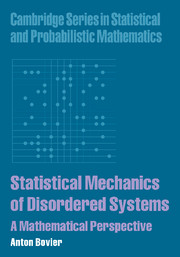7 - The random-field Ising model
Published online by Cambridge University Press: 25 January 2010
Summary
Quand les physiciens nous demandent la solution d'un problème, ce n'est pas une corvée qu'ils nous imposent, c'est nous au contraire qui leur doivent des remercîments.
Henri Poincaré, La valeur de la science.The random-field Ising model has been one of the big success stories of mathematical physics and deserves an entire chapter. It will give occasion to learn about many of the more powerful techniques available for the analysis of random systems. The central question heatedly discussed in the 1980s in the physics community was whether the RFIM would showspontaneous magnetization at lowtemperatures and weak disorder in dimension three, or not. There were conflicting theoretical arguments, and even conflicting interpretations of experiments. Disordered systems, more than others, tend to elude common intuition. The problem was solved at the end of the decade in two rigorous papers by Bricmont and Kupiainen (who proved the existence of a phase transition in d ≥ 3 for small ∈) and Aizenman and Wehr (who showed the uniqueness of the Gibbs state in d = 2 for all temperatures).
The Imry–Ma argument
The earliest attempt to address the question of the phase transition in the RFIM goes back to Imry and Ma in 1975. They tried to extend the beautiful and simple Peierls argument to a situation with symmetry breaking randomness. Let us recall that the Peierls argument in its essence relies on the observation that deforming one ground-state, +1, in the interior of a contour γ to another ground-state, −1, costs a surface energy 2|γ|, while, by symmetry, the bulk energies of the two ground-states are the same. Since the number of contours of a given length L is only of order CL, the Boltzmann factors, e–2βL, suppress such deformations sufficiently to make their existence unlikely if β is large enough.
- Type
- Chapter
- Information
- Statistical Mechanics of Disordered SystemsA Mathematical Perspective, pp. 111 - 158Publisher: Cambridge University PressPrint publication year: 2006
- 1
- Cited by



